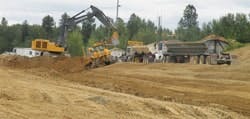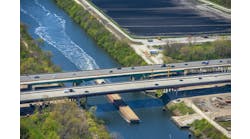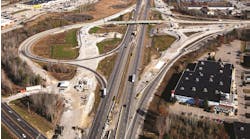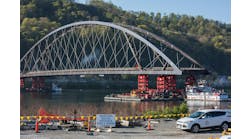PROJECT: U.S. 95 Sand Creek Byway Project
LOCATION: Sandpoint, Idaho
OWNER: Idaho Transportation Department
DESIGNERS: Washington Group International and CH2M Hill
CONTRACTOR: Parsons RCI Inc.
COST: $103 million
START DATE: November 2008
COMPLETION DATE: November 2012
Parsons RCI Inc. has to dig deep to construct the U.S. 95 Sand Creek Byway.
Not because the project demanded all of the company'?s resources, but because the soils were so unstable. The project required 798,000 cu yd of excavation.
?In northern Idaho they have a lot of questionable soils. They?'re not very stable. They?'re not very good for structural use,? Snaebjorn ?Snowbear? Jonasson, project manager for
Parsons, told ROADS & BRIDGES. ?So what we do is we excavate them out, and in many cases we do go below water level to start the undersea walls, coming back up to spread the footprint and spread the load of the road that is then built on top of the undersea walls.?
The constructor has to do a lot of deep soil stabilization and placement of cellular concrete as lightweight ? ll material. A good example of the use of cellular concrete is the area near Cedar Street, where there is an old railroad bridge over Sand Creek and a landmark railroad station built in 1907. Cellular concrete was placed adjacent to the building to limit ground vibrations and prevent settlement, which might damage the structural integrity of the building. At its deepest, the light yet strong cellular concrete was placed about 28 ft thick. The project runs only 2.1 miles in the town of Sandpoint, Idaho, but it runs along a narrow spit of land with Sand Creek to the west and Lake Pend
Oreille to the east. Running alongside the highway is a working railway. Two critical aspects of the project are to prevent construction-disturbed soil from washing into Sand Creek and to prevent construction-related vibrations from disturbing any of the railroad equipment.
The level of water in Sand Creek is controlled by the U.S. Army Corps of Engineers and is 10-13 ft higher in summer than in winter. Because of the extremes in water level, soil erosion was a major concern. The constructor has to take extensive erosion-control measures to prevent storm water from carrying soil into Sand Creek.
They are using mainly well-known best-management practices for erosion control, such as silt fences to delineate the perimeter of the construction area. They spray a stabilizer onto exposed soil. They also use silt curtains installed in the creek to limit turbidity near where they are building cofferdams and piers for a bridge over the creek.
Storm water on the construction site drains into a sediment pond, where it is treated before being discharged in accordance with the project?s storm-water pollution revention plan.
The adjacent BNSF Railway carries an average of 80 trains every 24 hours. Keeping the trains rolling and preventing settlement of any of the railway equipment is critical.
Retaining walls are another important element of the U.S. 95 Sand Creek Byway Project. In all, 35 mechanically stabilized earth, precast and cast-in-place, retaining walls are being built.
Other structures being built as part of the project include two pedestrian underpasses and a pedestrian and bike path that parallels the highway and four steel-girder highway bridges, two over navigable waters. The other two carry U.S. 95 over existing roads.



